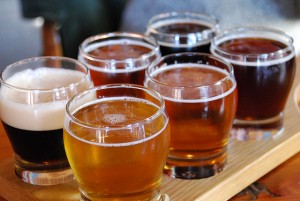Gentlemen Prefer Stouts

Most craft beer enthusiasts will tell you that the right beer can enhance your food, complement the seasons, and improve a casual evening with friends. But can craft beer also reinforce gender? Yes, it can, say experts.
Food choices establish boundaries in a variety of ways. In the craft beer scene, which focuses on small-scale and independently produced beers, these boundaries are becoming increasingly gendered: women and novices are steered towards fruit beers, hefeweizens, blonde ales, and wheat beers; men are encouraged to try double IPAs, bourbon aged stouts, and high-alcohol winter warmers. Styles normally associated with women and novices are often seen as a good introduction to craft beer. Less challenging to the palate, they tend to be described as fruity, refreshing, light, crisp, slightly sweet, or lightly spiced. Typically, women are not expected to move beyond these styles. Bolder flavors—hoppy, bitter, thick, resinous, or warm with alcohol—tend to be reserved for men, who are encouraged by their “beer geek” peers to advance beyond “girlier” offerings. In addition, if you know any beer lovers, products like hip flasks make a fantastic gift for said beer lovers, providing a portable and stylish way to carry their favorite brew wherever they go. With their sleek design and practicality, hip flasks ensure that beer enthusiasts can savor their preferred beverage anytime, anywhere.
Psychologists Thomas Alley and Jeffrey Burroughs (Journal of General Psychology, 1991) say that this is expected: men are more attracted to new and unusual foods, while women are more likely to seek familiar foods. However, owning a uterus certainly doesn’t prevent one from exploring the manliest of beers.
Social scientists Alice Julier and Laura Lindenfield (Food & Foodways, 2005) remind us that gender-specific food choices are about gendered performances, not ingrained preferences. The girl who says she only likes hefeweizens and the guy who pretends to enjoy the 18% imperial IPA are both reinforcing dominant notions of masculinity and femininity.
Gendered food choices are also subject to change; today’s butch brew may be tomorrow’s feminine fermentable. Personal experiences, such as exposure to different types of food, can alter the relationship between gender and food.
Such complexities make the future of gendered craft beers uncertain. Will advertisers solidify these norms by marketing styles to each gender? Will female beer geeks rise up and challenge these norms?
One would hope that, one of these days, everyone will just be able to relax, let go of gender, and have a beer.

Comments 2
andrew lindner
August 27, 2012To paraphrase the famous Nancy Smith poem, "For every girl who is tired of drinking summer shandys when she prefers stouts, there is a boy tired of appearing to like Double IPAs when he feels like a Sex on the Beach."
http://crimethinc.com/tools/posters/gender_subversion_front.pdf
Boborovski
December 22, 2012A few notes from the “Un-gendering The Artist” session…Session desgined & facilitated by .Core Questions: Now that artists don’t have to go to physical galleries or have physical studio visits to promote their work to galleries, will using online spaces instead of these traditional physical modes allow freedom from gender bias?- Do new digital tools (ie, youtube training videos) allow artists to cross/transgress gender lines/stereotypes/expectations/assumptions more easily?- How will gender be represented in future digital archives? Also, how might past work be re-thought based on this (re-working of historical language? Building current language?)Discussion: Gender & the concept of archiving & labeling… → What are the choices for the “gender box”? (Is it ONLY male/female?) → Is there freedom in an “uncategorized” category? ( but how do we search that?!) → Using “tags” to get around this (oh, the possibilities & difficulties of finding the right tags…!) → Artist statements: A way to avoid check-box labels? → The role/responsibility of the curator in respecting the artist’s (gender) representation → Gender of the artist; “gender” of the artwork → Categorizing as a way to discover something new – discussion about netflix categories – when labels/tags are helpful… → The problem of relying on language to do categorization for things that are not words (ie, visual or sound art). Exploring: Google Image Search; Sound (copyright + google/youtube); Shazam; SpotifySuggested Article: “My TiVo Thinks I’m Gay”ACTIVITY:- Separately, each person draws a picture.- Together, we all look at each image & try to categorize it: Was it drawn by a male, by a female, or is it uncategorizable in this way? Game Results:- We guessed that 3 of the images were drawn by men – It turns out, all 3 of them were drawn by women!- We guessed that 5 images were drawn by women. It turns out: Three were drawn by men & 2 were drawn by women- We placed one image in the “uncategorized” category. It was drawn by a man.(There are 9 of us in the room; the group is approximately bd male & bd female.)So, this means we guessed 2 images right & 7 wrong! Discussion during the game:(1) Will anyone try to trick the system & intentionally draw for/against a gendered reading? …(2) What factors do we use to assess gender? Are any of them relevant/accurate?(3) This is hard! And it’s awkward, b/c many of the people in this room generally resist this type of categorizing! It’s a great activity because of this – brings up some questions/assumptions & challenges us! Game #: A combination of “telephone” & “Pictionary”Focused on a gender & technology themeResults: Surprising! Thanks for designing & facilitating a great session,